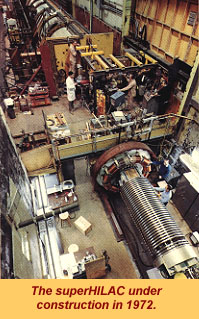
Nearly 200 years ago, Lord Byron argued that the best prophet of a successful future is a successful past. If Byron was correct, then the forecast for Berkeley Lab's accelerator-based boron neutron capture therapy (BNCT) proposal is exceptionally bright. To hold down costs, Berkeley Lab researchers will construct a new accelerator from the recycled parts of a famous old accelerator. The SuperHILAC, which stands for Super Heavy Ion Linear Accelerator, has been retired for almost five years, but in its prime, it was a one-of-a-kind machine that was used to make scientific history.
The SuperHILAC began its career in 1972 but it, too, sprang from the remains of an older accelerator the HILAC which was built in 1957. A "heavy" ion is a charged atom with two or more protons in its nucleus, which means every element on the periodic table from helium on up. The HILAC was one of the first machines that could accelerate elements as heavy as argon (atomic mass of 40) to "atom-smashing" energies. The Super-HILAC could accelerate all the natural elements including the heaviest, uranium, to such energies. This opened the door to the creation of synthetic elements beyond uranium, also known as transuranic elements.
The SuperHILAC was designed to operate with multiple injectors - small accelerators that lift the energies of particles and give them a running start - into a main accelerator for elevation to higher energies. Initially, the SuperHILAC was given two injectors, both Cockcroft-Walton voltage multipliers. The first injector was named "Eve." It was a 750-thousand volt high-current machine mainly used to accelerate lighter elements (argon and below) for biomedical studies.
The SuperHILAC's second injector was a two-million volt low-current machine that could accelerate all the elements on the table. It was mainly used in nuclear science studies and, was named "Adam." Unlike Eve, which was air-insulated, the larger and more powerful Adam was insulated with high pressure gas to withstand the high voltages needed to accelerate heavier ions. The insulated gas had to be enclosed inside a steel pressure tank. Adam's enclosure tank is one of the main components that will be recycled into the new ESQ accelerator for BNCT research.
In 1981, a third injector was added to the SuperHILAC family, a Wideroe linear accelerator which was coupled to a Cockcroft-Walton voltage multiplier that served as a pre-injector. This third injector system could produce heavy ion beams at 100 times the current extracted from Adam. It was named Abel.
In 1974, the SuperHILAC had itself become a sometime injector for the Bevatron, Berkeley Lab's huge synchrotron. When operating in tandem, the two accelerators were known as the Bevalac. With the addition of Abel to the SuperHILAC, the Bevalac became the only facility in the world that could bombard targets with highly energized uranium ions.
Like the phoenix, the legendary bird that rises from the ashes of its immediate ancestor, the SuperHILAC arose in various incarnations through a period covering four decades. In the hands of fabled scientific explorers such as Berkeley Lab's Albert Ghiorso, this facility played a part in the discovery of five superheavy elements, including 106, named seaborgium, for Berkeley Lab Nobel laureate and transuranic pioneer Glenn Seaborg. The SuperHILAC was also the launchpad for a variety of major experiments, including the creation of exotic states of matter, that led to a better understanding of nuclear structure. On December 23, 1993, the Super-HILAC was turned off for the last time.
 RETURN TO TABLE OF CONTENTS
RETURN TO TABLE OF CONTENTS